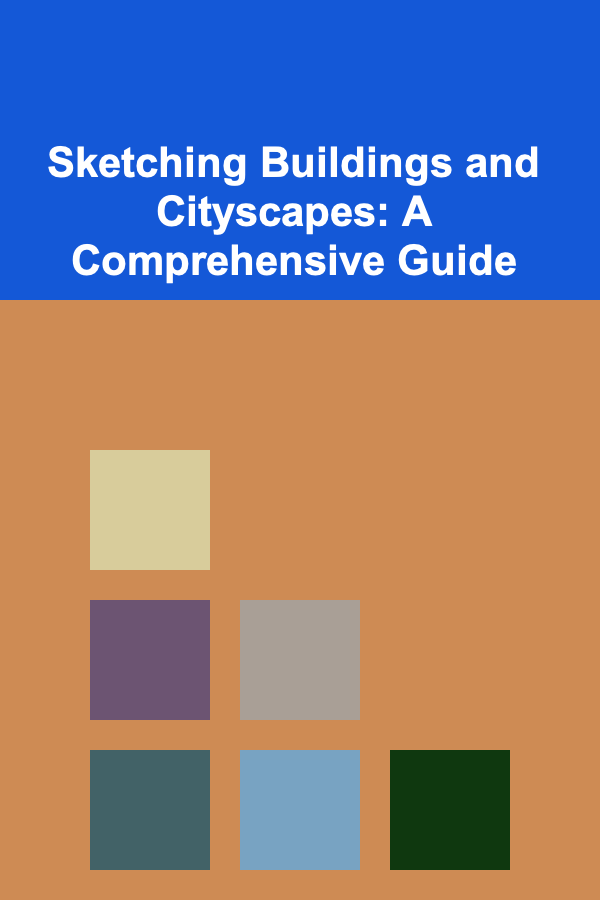
Sketching Buildings and Cityscapes: A Comprehensive Guide
ebook include PDF & Audio bundle (Micro Guide)
$12.99$10.99
Limited Time Offer! Order within the next:

Sketching buildings and cityscapes is a rewarding skill that allows you to capture the essence of urban environments with your own personal touch. Whether you're a seasoned artist or just starting out, this guide will provide you with a comprehensive understanding of the techniques, concepts, and practice required to create compelling architectural sketches. We'll cover everything from basic perspective principles to advanced rendering techniques, helping you develop your own unique style.
Understanding the Fundamentals
Before diving into complex architectural details, it's crucial to grasp the foundational principles that underpin successful sketching. This includes understanding perspective, proportion, and basic shapes.
Perspective: Creating Depth and Realism
Perspective is the technique of representing three-dimensional objects on a two-dimensional surface in a way that mimics how they appear to the human eye. Mastering perspective is essential for creating realistic and convincing architectural sketches.
There are three main types of perspective:
- One-Point Perspective: All lines converge to a single vanishing point on the horizon line. This is best used for scenes where you're looking directly at the front of a building.
- Two-Point Perspective: Lines converge to two vanishing points on the horizon line. This is ideal for sketching buildings viewed from an angle.
- Three-Point Perspective: Lines converge to three vanishing points (two on the horizon line and one either above or below). This is used to represent buildings viewed from a very high or very low angle, often creating a dramatic effect.
Horizon Line (Eye Level): The horizon line represents your eye level and is the foundation for constructing perspective. All vanishing points lie on the horizon line.
Vanishing Points: These are points on the horizon line where parallel lines appear to converge. Their placement significantly impacts the perspective and overall composition of your sketch.
Practical Application: Start by lightly sketching the horizon line. Then, decide on the type of perspective you want to use and mark the vanishing point(s). Use a ruler or straight edge (initially, at least) to draw lines converging towards the vanishing point(s) from the corners of the building. These lines will define the edges and proportions of your structure.
Example: One-Point Perspective
- Draw a horizon line.
- Mark a single vanishing point on the horizon line.
- Draw a rectangle to represent the front face of the building.
- Draw lines from each corner of the rectangle to the vanishing point.
- Decide how deep you want the building to be and draw a line across the converging lines, parallel to the front of the building, creating the back face.
- Erase the unnecessary lines.
Proportion: Capturing Accurate Relationships
Proportion refers to the relative size and scale of different elements within a building or cityscape. Accurate proportions are essential for creating a realistic and believable sketch.
Tips for Accurate Proportions:
- Establish a Reference Point: Choose a key feature, such as a door or window, and use it as a reference for gauging the size of other elements.
- Use Ratios: Compare the height and width of different parts of the building using ratios. For example, "the window is half as wide as the door is tall."
- Squint Your Eyes: Squinting helps you simplify the scene and focus on the overall shapes and proportions, rather than getting bogged down in details.
- Practice Comparative Measurement: Hold your pencil at arm's length and use your thumb to mark off the height of one element. Then, compare that measurement to other elements in the scene.
Basic Shapes: Simplifying Complexity
Buildings, no matter how complex they may seem, are ultimately composed of basic geometric shapes like cubes, rectangles, cylinders, and cones. By breaking down a building into these simple forms, you can simplify the sketching process and create a solid foundation for adding details.
How to Use Basic Shapes:
- Observe the Overall Form: Identify the dominant shape of the building. Is it primarily a cube, a rectangle, or a combination of shapes?
- Break it Down: Divide the building into smaller, simpler shapes. For example, a roof might be represented as a triangle or a cone.
- Refine the Shapes: Gradually refine the basic shapes by adding details and curves to create a more accurate representation of the building.
Materials and Tools
The right tools can significantly enhance your sketching experience and the quality of your work. Here are some essential materials and tools for sketching buildings and cityscapes:
- Pencils: A range of pencils with varying lead hardness (e.g., HB, 2B, 4B) is essential for creating different values and textures. Softer leads (like 4B) are ideal for shading and creating dark tones, while harder leads (like HB) are better for fine lines and details. A mechanical pencil (0.5mm or 0.7mm) is great for precise linework.
- Erasers: A kneaded eraser is perfect for lifting graphite and creating subtle highlights. A white plastic eraser is useful for removing larger areas of graphite. A pencil eraser can be used for precise erasing in small areas.
- Sketchbook/Paper: Choose a sketchbook or paper that is suitable for sketching. Look for paper with a smooth or slightly textured surface. Heavier weight paper (at least 90lb) is recommended if you plan to use wet media like ink or watercolor.
- Ruler/Straight Edge: Essential for creating straight lines and accurate perspective. A metal ruler is more durable than a plastic one.
- Blending Stumps/Tortillions: These are useful for blending graphite and creating smooth tonal transitions.
- Optional:
- Ink Pens: Fine liner pens (e.g., Sakura Pigma Micron) are great for adding detail and creating permanent lines.
- Watercolor Pencils/Paints: These can be used to add color and create washes.
- Markers: Alcohol-based markers (e.g., Copic) are useful for adding bold colors and creating graphic effects.
- Perspective Grid Templates: These can be helpful for beginners to establish correct perspective quickly.
The Sketching Process: Step-by-Step
Here's a step-by-step guide to sketching buildings and cityscapes, breaking down the process into manageable stages:
1. Observation and Composition
Before you start sketching, take some time to carefully observe the building or cityscape you're planning to draw. Consider the following:
- Overall Shape and Structure: What are the dominant shapes and how do they relate to each other?
- Perspective: Identify the vanishing points and horizon line. What type of perspective is most suitable for the scene?
- Light and Shadow: Notice how light falls on the building and creates shadows. Where are the highlights and darkest areas?
- Details: What are the key architectural details that define the building's character?
Composition: Think about the arrangement of elements within your sketch. Consider the following compositional principles:
- Rule of Thirds: Divide your sketch into nine equal parts using two horizontal and two vertical lines. Place key elements along these lines or at their intersections to create a more dynamic composition.
- Leading Lines: Use lines to guide the viewer's eye through the sketch.
- Focal Point: Choose a focal point that draws the viewer's attention. This could be a prominent architectural feature or a contrasting element.
- Negative Space: Pay attention to the space around the buildings. Negative space can help to emphasize the subject and create a sense of balance.
2. Establishing the Framework
Begin by lightly sketching the basic shapes and perspective lines. This stage is about creating a foundation for your sketch, so don't worry about details yet.
- Horizon Line and Vanishing Points: Draw the horizon line and mark the vanishing point(s) according to the chosen perspective.
- Basic Shapes: Sketch the basic shapes of the building(s) using light lines.
- Perspective Lines: Draw lines converging towards the vanishing point(s) from the corners of the building(s) to establish the correct perspective.
3. Refining the Shapes and Adding Details
Once you have established the framework, you can begin to refine the shapes and add architectural details. This stage requires careful observation and attention to detail.
- Correcting Proportions: Adjust the proportions of the building(s) based on your observations. Use a reference point to gauge the size of other elements.
- Adding Architectural Details: Sketch in windows, doors, roofs, and other architectural features. Pay attention to their shape, size, and placement.
- Line Weight: Vary the thickness of your lines to create depth and emphasis. Use thicker lines for outlines and areas in shadow, and thinner lines for details and areas in light.
4. Adding Tone and Shading
Adding tone and shading is crucial for creating depth and realism in your sketch. This involves using different values of graphite (or other media) to represent light and shadow.
- Identifying Light Source: Determine the direction of the light source and how it affects the building(s).
- Creating Values: Use different pencils or shading techniques to create a range of values from light to dark.
- Shading Techniques:
- Hatching: Creating lines parallel to each other.
- Cross-Hatching: Overlaying layers of hatching at different angles.
- Stippling: Creating dots to represent value.
- Blending: Smudging graphite to create smooth tonal transitions.
- Shadows: Pay attention to cast shadows (shadows cast by the building onto the ground or other surfaces) and form shadows (shadows that define the shape of the building).
- Highlights: Leave areas of white paper to represent highlights. You can also use a kneaded eraser to lift graphite and create highlights.
5. Adding Texture and Details
Adding texture and small details can bring your sketch to life and create a sense of realism. This might include adding details to the facade, rendering materials like brick or stone, or adding elements like trees or people.
- Surface Textures: Use different shading techniques to represent the textures of different materials. For example, you could use short, irregular lines to represent brick or stone.
- Adding Context: Include elements like trees, people, cars, or street furniture to add context and scale to your sketch.
- Details: Add small details like window frames, door handles, or signs to create a sense of realism.
6. Final Touches and Refinements
Once you've completed the basic sketch, take some time to review your work and make any necessary refinements. This might involve adjusting the composition, adding more details, or cleaning up any stray lines.
- Composition Review: Check the overall composition and make sure the focal point is clear.
- Detail Refinements: Add any missing details or refine existing details.
- Line Weight Adjustment: Adjust the line weight to create emphasis and depth.
- Clean Up: Erase any unnecessary lines or smudges.
Advanced Techniques
Once you've mastered the fundamentals, you can explore more advanced techniques to enhance your architectural sketches.
Atmospheric Perspective
Atmospheric perspective (also known as aerial perspective) is a technique used to create a sense of depth by simulating the effects of the atmosphere on distant objects. As objects recede into the distance, they appear lighter in value, less detailed, and bluer in color.
How to Apply Atmospheric Perspective:
- Value: Make distant objects lighter in value than closer objects.
- Detail: Reduce the amount of detail in distant objects.
- Color: Add a slight blue tint to distant objects.
Rendering Materials
Rendering different materials effectively is crucial for creating a realistic and believable architectural sketch. Each material has its own unique texture and reflective properties, which need to be represented accurately.
Tips for Rendering Materials:
- Brick: Use short, irregular lines to represent the individual bricks. Pay attention to the pattern and texture of the brickwork.
- Stone: Use a variety of shading techniques to represent the rough, uneven surface of stone.
- Glass: Use light values and subtle reflections to represent the transparent quality of glass.
- Metal: Use a combination of light and dark values to represent the reflective surface of metal.
- Wood: Use parallel lines and subtle variations in value to represent the grain of wood.
Adding Human Figures and Vehicles
Adding human figures and vehicles to your sketch can add scale, context, and a sense of life to the scene.
Tips for Adding Figures and Vehicles:
- Keep it Simple: Don't try to render figures and vehicles in too much detail. Focus on capturing their basic shape and posture.
- Use Silhouettes: Silhouettes can be effective for representing distant figures and vehicles.
- Consider Scale: Make sure the figures and vehicles are in proportion to the buildings and other elements in the scene.
- Implied Motion: You can suggest motion by slightly blurring the lines or adding a sense of speed to the vehicles.
Developing Your Own Style
While it's important to learn the fundamentals and techniques of sketching, it's also essential to develop your own unique style. Experiment with different materials, techniques, and approaches to find what works best for you.
Tips for Developing Your Style:
- Experiment with Different Materials: Try using different types of pencils, pens, markers, or paints to see how they affect your sketches.
- Explore Different Techniques: Experiment with different shading techniques, line weights, and compositional approaches.
- Study Other Artists: Look at the work of other artists and architects to get inspiration. Pay attention to their style, techniques, and subject matter.
- Practice Regularly: The more you sketch, the more you'll develop your own unique style.
- Don't Be Afraid to Make Mistakes: Mistakes are a valuable part of the learning process. Don't be afraid to experiment and try new things.
Tips and Tricks
Here are some additional tips and tricks to help you improve your architectural sketching skills:
Tip: Practice sketching from photographs: This is a great way to improve your observational skills and learn how to represent different architectural styles and details.
Tip: Use a viewfinder: A viewfinder can help you to frame your scene and focus on the essential elements.
Tip: Take breaks: Stepping away from your sketch for a few minutes can help you to see it with fresh eyes and identify areas for improvement.
Tip: Carry a sketchbook with you: This will allow you to capture interesting buildings and cityscapes whenever and wherever you find them.
Tip: Join a sketching group or class: This is a great way to learn from other artists and get feedback on your work.
Conclusion
Sketching buildings and cityscapes is a rewarding and challenging skill that can be developed with practice and dedication. By understanding the fundamentals of perspective, proportion, and composition, and by mastering various sketching techniques, you can create compelling and expressive architectural sketches that capture the essence of the urban environment. Remember to experiment, develop your own style, and most importantly, enjoy the process!

How to Make Use of Lofted Spaces for Extra Storage
Read More
How To Understand Cash Flow Management for Small Businesses
Read More
How to Use Multi-Functional Furniture for Extra Storage
Read More
Renting vs. Buying Comparison: Which Option Is Best for You?
Read More
Blockchain in Agriculture: Enhancing Traceability and Trust
Read More
How to Prepare for Seasickness: A Cruise Checklist
Read MoreOther Products

How to Make Use of Lofted Spaces for Extra Storage
Read More
How To Understand Cash Flow Management for Small Businesses
Read More
How to Use Multi-Functional Furniture for Extra Storage
Read More
Renting vs. Buying Comparison: Which Option Is Best for You?
Read More
Blockchain in Agriculture: Enhancing Traceability and Trust
Read More